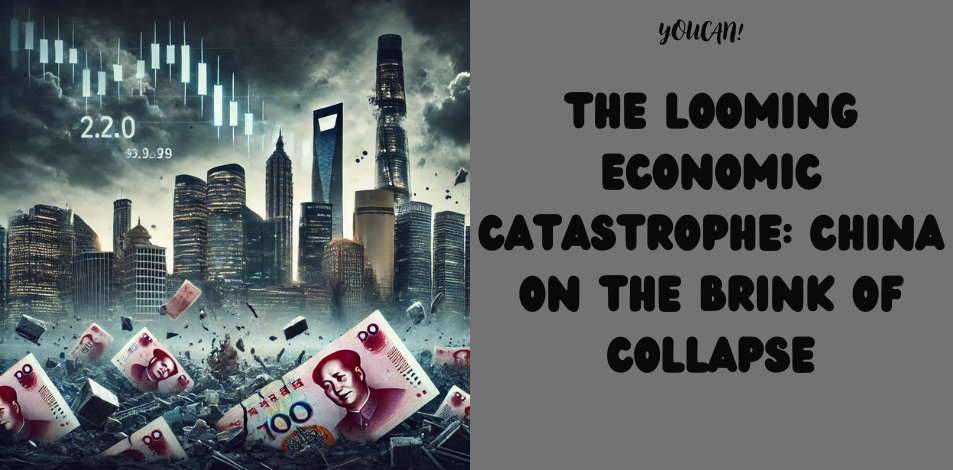
Part 1: Unpacking the Economic Pressures
China, long hailed as a global economic powerhouse, now finds itself teetering on the edge of potential collapse. While China’s meteoric rise has been an inspiration for developing nations, its massive economy is beginning to show signs of stress. Several underlying issues threaten the stability of this seemingly unshakable giant, making experts wonder if we are witnessing the beginning of China’s economic unraveling.
One of the most significant factors contributing to China’s precarious situation is the staggering amount of debt. Chinese local governments, state-owned enterprises, and private firms have borrowed heavily over the last two decades to fuel rapid infrastructure projects, industrial expansion, and real estate growth. Total debt in China has ballooned to over 300% of its GDP, a staggering number for any nation.
This debt-fueled growth strategy, initially successful in creating jobs and building modern cities, has begun to backfire. China’s economic expansion has been driven by inefficient, state-directed investments, leading to “ghost cities” and underutilized infrastructure. As economic returns on these investments dwindle, China’s capacity to manage its mounting debt is becoming increasingly limited. Global investors are growing wary, raising concerns about the potential for widespread defaults and financial instability.
Part 2: Demographic Decline and Workforce Woes
China’s demographic challenges present another layer of complexity to its economic woes. For decades, China’s one-child policy led to a shrinking population and an aging workforce. Now, China faces the daunting task of supporting a growing elderly population with fewer young workers entering the labor force. The consequences of this demographic shift are far-reaching.
With fewer working-age individuals, China risks a severe labor shortage that could cripple industries and stifle economic growth. The shrinking workforce means reduced productivity and consumption, leading to a slowdown in demand for goods and services. At the same time, the burden of caring for the elderly will fall on the state and the working population, placing enormous financial strain on the government and families alike.
This demographic shift also undercuts China’s traditional role as the world’s manufacturing hub. As wages rise and the labor force shrinks, multinational companies may relocate their operations to other countries with younger, cheaper labor forces, such as Vietnam or India. Losing its competitive edge in manufacturing could further erode China’s economic growth prospects.
Part 3: Geopolitical Risks and Global Repercussions
China’s internal problems are compounded by its fraught geopolitical environment. Trade tensions with the United States, especially the escalating tech rivalry, have disrupted supply chains and created uncertainty for Chinese exporters. While China once relied heavily on exports to drive its economy, the current global climate has made this more difficult. The U.S. has implemented tariffs, restricted access to critical technologies like semiconductors, and pressured allies to limit their engagement with China.
In response, China has pivoted toward its domestic markets and sought to diversify trade partnerships, but this strategy has limitations. China’s economic slowdown is already affecting global supply chains, causing ripple effects that are being felt worldwide. A full-scale collapse would create shockwaves that could plunge the global economy into recession, disrupting industries from electronics to pharmaceuticals.
Furthermore, China’s political leadership under President Xi Jinping has tightened control over various sectors, leading to a regulatory crackdown on industries like technology, education, and real estate. This has spooked both domestic and international investors. The abruptness of these regulatory moves and a lack of transparency have made the Chinese market appear more volatile and less predictable, deterring foreign capital that China needs to sustain growth.
Conclusion: A Precarious Future for China and the World
The potential collapse of China’s economy is no longer a far-fetched scenario. The confluence of massive debt, demographic decline, and growing geopolitical risks have created a perfect storm of instability. Should China fail to address these challenges with effective reforms, the consequences will extend far beyond its borders. A collapse would have catastrophic effects on the global economy, particularly in industries that rely on Chinese manufacturing and trade.
The world watches as China navigates this treacherous path. Its decisions in the coming years will not only determine the fate of its own economy but could also reshape the global economic landscape for decades to come.




